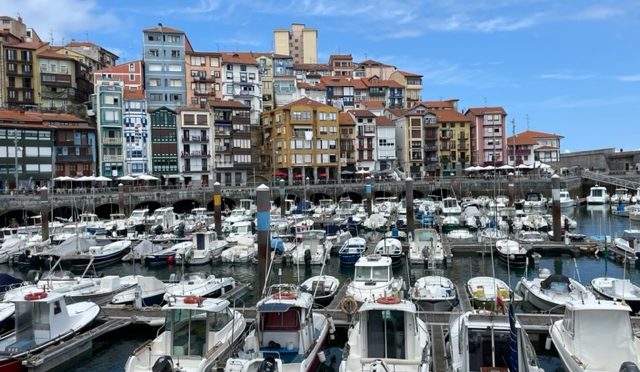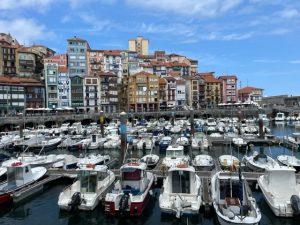A few weeks ago, after a few days in Barcelona, we went to the Basque Country. Traveling with a childhood friend and his family, we found an awesome Airbnb in Bermeo, a delightful port city on the coast of Bizkaia. I’d been there before – my dad’s brother Jose and his wife Eli used to work there – and I’m always charmed by the bright and colorful apartment buildings that line the main port. While a little out of the way from the heart of Bizkaia, it was still a great home base for us. By coincidence, my mom’s neighbor Gloria Lejardi was there with her daughter and grandkids, taking Euskara classes.
- In the Middle Ages, the center of Bermeo was surrounded by a massive stone wall with seven different gates offering access: Las Ferrerías, Burgos, San Juan, La Baca, Nuestra Señora de los Remedios, Santa Bárbara, and San Miguel. Today, the only one that is still standing is San Juan, though remains of some of the others still exist.
- However, Bermeo has a much older history than that. Roman coins have been found in both the port and one of the hermitages, suggesting the village existed in Roman times. In any case, historical mentions of Bermeo go back as far as any of Bizkaia – back to 1051 – and Bermeo was mentioned in the context of the Kingdom of Pamplona/Nafarroa. The importance of Bermeo to the history of Bizkaia is reflected in the fact that it was once, before Bilbo, the capital of the province.
- By the thirteenth century, Bermeo was an important port city, where merchants traded things like Castilian wool and salted fish with the biggest ports of Europe in England, France, and Flanders. This economic growth was spurred, in part, by special privileges afforded the city and the granting of a charter and fueros around 1236.
- By the next century, Bermeo was the most important port in Bizkaia. However, with the founding of Bilbo in 1300, by the end of the fourteenth century and particularly in the fifteenth, Bermeo began to loose importance to Bilbo. At its lowest point, only 500 people lived in the village. (Today, Bermeo boasts a population of about 17,000.) Bermeo saw more than a few fires and conflict with England during these times. There were also internal squabbles between the most notable families of Bermeo, the Asoagas (later split into the Arilzas, Almendurus and Arósteguis) and the Apiozas that led to the mingling of other notable families of Bizkaia into the affairs of Bermeo. Some Bermeo sailors become involved in piracy against other nations and exploring the African coast. Some of these are also part of the first trip around the world.
- In 1504, yet another fire ravaged the town, nearly destroying it. And another fire hit the town in 1722.
- In the late 1700s, batteries were installed both at Tompon Nagusi and at the port to defend the village against pirates.
- Bermeo was also the scene of an important offensive in the Spanish Civil War. The “Black Arrows,” a nationalist troop comprised mostly of Italians, made their way to Bermeo with little resistance. However, the Basques cutoff the road out and essentially trapped the Black Arrows in the town. If it hadn’t been for the air support afforded to the nationalist forces, the Basques might have been able to hold the town. In the end, however, Bermeo ultimately fell to Franco’s forces.
- Today, Bermeo is still one of the most important fishing ports in the Basque Country. Indeed, Bermeo is home to the Tuna World Capital, an association of tuna-fishing cities that are working to promote a sustainable and environmentally healthy tuna industry.
Primary sources: Castaño García, Manu. BERMEO. Auñamendi Encyclopedia. Available at: https://aunamendi.eusko-ikaskuntza.eus/en/bermeo/ar-13316/; Bermeo, Wikipedia; Bermeo, Wikipedia




We spent a few days in Bermeo last summer and I really liked the place. We stayed in a hotel in the old part of town, near the docks. The guide at the visitor center told us about the fisherman museum there (Arrantzaleen Museoa). I want to visit it on my next trip.
arrantzaleenmuseoa@bizkaia.eus
Thank you Blas!!!
Also we stayed in Lekeitio two nights and drove to Bilbao to see the Guggenheim. The mountain driving and the rains in May were a real challenge for me since I was not driving…lesson learned! The low clouds and rainy conditions made the passenger experience very unattractive 🥴, unfortunately. The trip over to Bidarray was also a challenge but great to see my family! The Centro of Lekeitio was wonderful but otherwise I will skip a future visit. Bermeo seems a much better choice!
I know how you feel. When I was there the first time, I rode in the back as my uncles drove and I usually got sick. They had no fear and no concept of slowing down around curves. It was rough.
This time, I was the driver, trying to guide a 9-person van through those roads. No one got sick on my watch, as far as I could tell, so hopefully I did a decent job. 🙂
You are the best travel guide/historian for a quick lesson on anything Basque. We loved our stay in Bermeo and the locals made us feel so welcome. The Fisherman’s Museum and the Tala are worth seeing, for sure, plus the small beach called Aritzatxu.
Thanks Gloria! Though, you were an excellent guide for things to try in Bermeo. Without you, we wouldn’t have found Aritzatxu, which was awesome! And it was great just knowing someone there. It makes things so completely different to be able to do fiesta with friends!